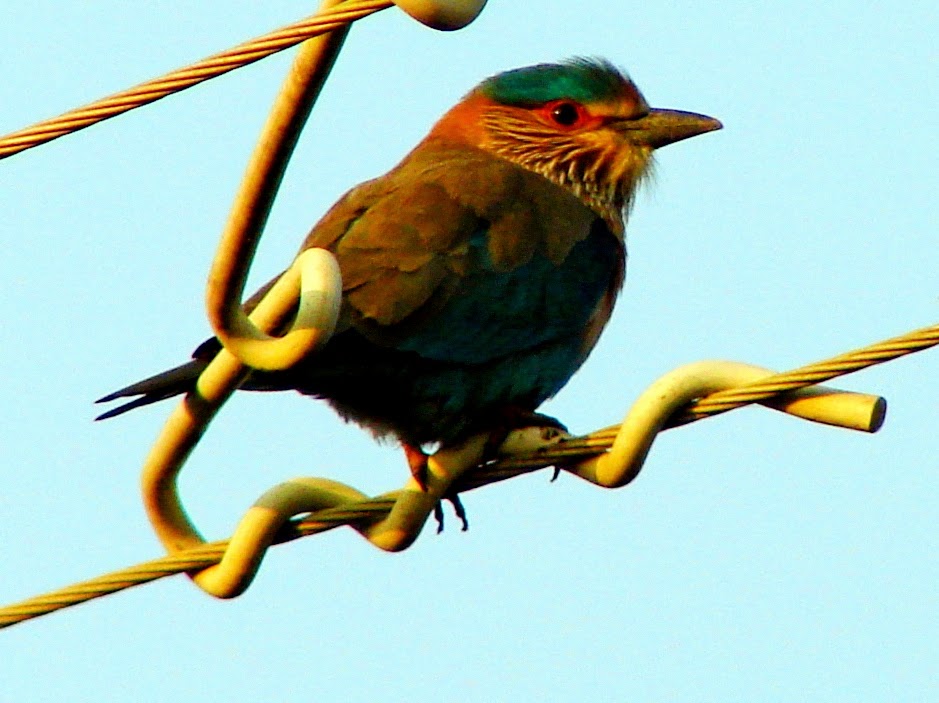Favorites
This is the fourth post and will cover some of the photographs that have given me a lot of satisfaction. Photographing birds has many challenges - not the least being the subjects not very inclined to pose for you. Also, the distance and lighting conditions are never ever perfect. So the hit rate, at least for me, for getting good photographs is very low.
This is a Black Shouldered Kite which was captured while on the way back from our farm in Medchal. It was perched on top of a concrete pole and busy with it's kill - probably a rat or lizard. Once it saw me approaching, it flew the next pole carrying it's kill. I followed and got some more shots. The local name is interesting - Adavi Ramadasu.
This is a Black Kite that I shot near a small lake/swamp near the RKPuram Flyover. The stink of the place was worth it to get a shot at this beautiful regal looking bird.
These are two Grey Herons that almost appear to be greeting each other. I captured this shot at a small pond (made by a rock quarrying) and happened to see one Grey Heron. While getting closer, it took off and then decided to land next to his friend and it was a very lucky shot to have captured it just as it was landing and the other Heron was looking up.
At the same pond where I captured the Grey Herons, we (my daughter and I) shot this Pied Kingfisher. We were quite enthralled by the way it was "fishing". It would hover over the water for a few seconds and then dive straight in to come out with a fish. We did capture one shot with a fish in it's beak, but it was too far. It is called Neela Buchigaadu in Telugu.
This is an Indian Pond Heron about to take off from it's stone perch. Though I was not planning for this, the graceful liftoff position almost looks like a 100mt sprint athlete about to start.Despite it's apparent speed in this photograph, this Heron can stay very still in the water waiting for fishes and then strike.It is called Narayana Konga in telugu.
This is the Asian Pied Startling that is usually found near water bodies and which are usually very dirty and smelly within the city. It is related to the Myna and is called Venda Gorinka in Telugu.
The look that I got from this Spotted Owl was a bit unnerving as it stared unblinkingly all the while. Once it realized that I was not going away and not getting intimidated, it flew away. It is called Pagati Kante in local telugu.
The Indian Roller is a very colorful bird and is also the state bird of Andhra Pradesh. It's local telugu name is Pala Pitta and people feel it is auspicious to see it on Dussehara, one of the most important festival in India.
For the rest of my bird photographs, please visit Birds Around Hyderabad.
The telugu names of some of these birds are from the excellent Universities Press/WWF published "The common Birds and Mammals of Andhra Pradesh".
A great site for many other photographs of Indian Birds is Indian Birds
This is the fourth post and will cover some of the photographs that have given me a lot of satisfaction. Photographing birds has many challenges - not the least being the subjects not very inclined to pose for you. Also, the distance and lighting conditions are never ever perfect. So the hit rate, at least for me, for getting good photographs is very low.
This is a Black Shouldered Kite which was captured while on the way back from our farm in Medchal. It was perched on top of a concrete pole and busy with it's kill - probably a rat or lizard. Once it saw me approaching, it flew the next pole carrying it's kill. I followed and got some more shots. The local name is interesting - Adavi Ramadasu.
This is an Indian Pond Heron about to take off from it's stone perch. Though I was not planning for this, the graceful liftoff position almost looks like a 100mt sprint athlete about to start.Despite it's apparent speed in this photograph, this Heron can stay very still in the water waiting for fishes and then strike.It is called Narayana Konga in telugu.
This is the Asian Pied Startling that is usually found near water bodies and which are usually very dirty and smelly within the city. It is related to the Myna and is called Venda Gorinka in Telugu.
The look that I got from this Spotted Owl was a bit unnerving as it stared unblinkingly all the while. Once it realized that I was not going away and not getting intimidated, it flew away. It is called Pagati Kante in local telugu.
The Indian Roller is a very colorful bird and is also the state bird of Andhra Pradesh. It's local telugu name is Pala Pitta and people feel it is auspicious to see it on Dussehara, one of the most important festival in India.
For the rest of my bird photographs, please visit Birds Around Hyderabad.
The telugu names of some of these birds are from the excellent Universities Press/WWF published "The common Birds and Mammals of Andhra Pradesh".
A great site for many other photographs of Indian Birds is Indian Birds




.JPG)






















